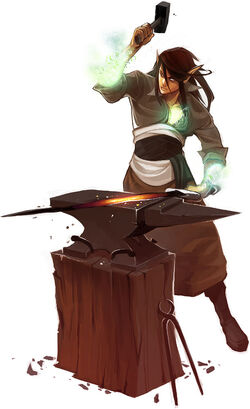| Axiomite | |
|---|---|

| |
| (Creature) | |
| Type | Outsider (extraplanar) |
| CR | 8 |
| Environment | Axis |
| Alignment | |
Source: The Great Beyond: A Guide to the Multiverse, pg(s). 56-57 | |
The lords, caretakers, and architects of the eternal city of Axis, axiomites (pronounced AK-see-oh-mite)[1] possess a wide variety of outward forms which is somewhat odd for creatures of pure law.
Appearance[]
There is no uniform appearance for an axomite as axiomite society contains those who resemble flawless, perfect humanoids of all descriptions including humans, elves, tieflings, dwarves, halflings, giants, and even gnomes—but these outward shapes belie their true forms, which can be seen briefly whenever the axiomites move or perform any complex actions. During such moments their bodies partly dissolve into glowing clouds of golden, crystalline dust. The clouds move and contort of their own accord, temporarily congealing into twisting lines of mathematic symbols and complex tangles of equations. Each axiomite is actually an immortal construct of living, intelligent mathematics approximating a humanoid shape.[2]
Habitat & Ecology[]
The only place axiomites call home is the perfect city of Axis but they can be found elsewhere either trying to understand some fundamental laws of the universe or expand the borders of their home plane. The ecology of the axiomites is bizarre and could only exist in the Outer Sphere. According to their records the axiomites were the first creatures to inhabit the city of Axis and were manifest from the mathematical laws that underlie all existence. The axiomite claim that they are actually the laws of reality made manifest in order to understand themselves. While this may have been the case millennia ago it is not so now as new axiomites, like many outsiders, are created from the souls of mortals that find their way to Axis. When asked the axiomites claim that this is an adjustment to the changing laws that govern all existence; as demons, devils, and all sorts of other outsiders reproduce using mortal souls so too do the axiomites. The actual transformation of a soul into an axiomite is a mysterious process. The soul experiences a strong call towards one of the axiomite constructions (anxiomites describe this as "the call of the God Mind" or "answering the resonance"). Each of these structures is related to a single class of laws with each construction attracting souls with similar interests. Once a soul reaches one of these structures they touch it and disappear within for several days. When they emerge they are an axiomite.[3]
Society[]
The society of axiomites is surprisingly inward focused, with a third of axiomite society devoted to exploring and understanding the laws that make up the universe. The other two thirds are devoted to the betterment of Axis with a third maintaining and adding new buildings to Axis while the other third takes care of the construction and maintenance of the army of inevitables. Despite its three separate focuses, axiomite society moves with a single purpose. The entire race is ruled by the Transcendental Council of the Defined Infinite or as it is more commonly known the Godmind of Axis. The Godmind is not a single creature but a composite of the greatest axiomite minds from each of the three focuses of their society. These axiomites combine to form a single super-intelligence that calculates the best course of action for the entire race then splits back into its composite creatures to ensure its decision is carried out. This meeting of the Godminds only occurs when some previous calculation or plan of the Godmind goes awry, comes to completion, or requires drastic alteration.[3] The last time there was a manifestation of the Godmind was in the wake of Aroden's death heralding the Age of Lost Omens. The manifestation lasted three whole days, and for this time Axis ground to a halt. The Godmind rewrote its formulas and plans with variables and equations previously impossible, the death of Aroden causing an upheaval in Axis equal to that which it caused on Golarion.[4]
References[]
- ↑ Erik Mona et al. (2008). Campaign Setting, p. 246. Paizo Publishing, LLC. ISBN 978-1-60125-112-1
- ↑ Todd Stewart. (2009). The Great Beyond: A Guide to the Multiverse, p. 56. Paizo Publishing, LLC. ISBN 978-1-60125-167-1
- ↑ 3.0 3.1 Todd Stewart. (2009). The Great Beyond: A Guide to the Multiverse, p. 57. Paizo Publishing, LLC. ISBN 978-1-60125-167-1
- ↑ Todd Stewart. (2009). The Great Beyond: A Guide to the Multiverse, p. 31. Paizo Publishing, LLC. ISBN 978-1-60125-167-1
